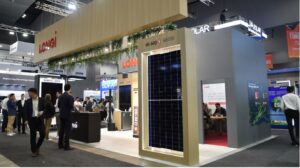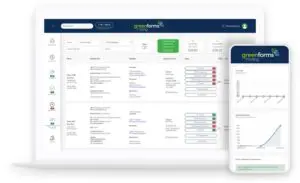PRESS RELEASE

Australian battery company Redflow Limited (ASX:RFX) has simplified using its batteries in large energy storage systems by integrating plug-and-play technology into its LSB (Large Scale Battery) reference platform.
Implemented in an LSB installed at Simon Hackett’s Base64 property in Adelaide, the new design incorporates six 12-kilowatt (kW) Victron Quattro 48/15000 battery inverter/chargers with 45 Redflow ZBM2 batteries. By implementing this improved design, the Base64 LSB will deliver an energy storage capacity of 450 kilowatt-hours (kWh).
The LSB Reference Platform is a container-sized deployment of Redflow batteries, which can operate as a single ‘virtual” battery to assist Redflow system integrators with designing and deploying larger energy storage systems. Base64 installed its original LSB in 2016, running it for about a year before undertaking the redesign process in conjunction with Redflow.
The redesigned LSB is installed at the back of Base64’s western carpark, beneath an innovative tree-like mounting system that ‘floats’ a 50 kilowatt peak (kWp) array of solar panels above staff and visitor cars. Base64 has an additional 20kWp of solar panels installed elsewhere in the precinct.
Base64 Managing Director Simon Hackett, who is a non-executive director of Redflow, described the Base64 energy system as a “fantastic learning experience”. “The system is built around a Redflow ZBM2 LSB battery system, which is charged by energy harvested from our solar array,” he said.
“Although we initially purchased a large industrial AC inverter with the LSB, it lacked the monitoring, logging or control systems to let it interact with our on-site solar. While we could charge and discharge our large battery ‘manually’, we couldn’t integrate it with the building, without an expensive consulting project to develop a bespoke third-party control system.”
Mr Hackett said the solution appeared after he gained deep experience using Victron Energy inverter/charger systems. “All of the energy system control, management and data logging technology we needed comes ‘out of the box’ with the Victron Energy CCGX controller unit,” he said.
“Industrial scale systems are still in the dark ages in terms of the stuff that Victron Energy has ‘nailed’. Victron supplies great, easy to use, easy to understand, effective and powerful out-of-the-box energy system control software and hardware. It also comes with an excellent integrated web-accessible portal for remote data logging, analysis and remote site system control.
“So, we pulled the LSB apart and rebuilt it using Victron Energy products and control systems to deliver a fantastic operational result, with optimal use of the solar energy to drive the building, charge the batteries, and support the building load at night – just like at home, but on a large scale – without facing a huge software development cost for just the old proprietary inverter system.
“It’s very satisfying to run an office in the middle of a major city that typically uses very little grid energy, is resilient to grid faults, and even exports solar energy to the grid.
“Using Victron plug-and-play systems has turned out far cheaper and better than bespoke software would have. It also creates a signature example of a large-scale Victron Energy deployment running a substantial multi-building site. I hope this redesigned LSB inspires members of the global Victron Energy installation community to consider using Redflow battery technology at this sort of scale.”












